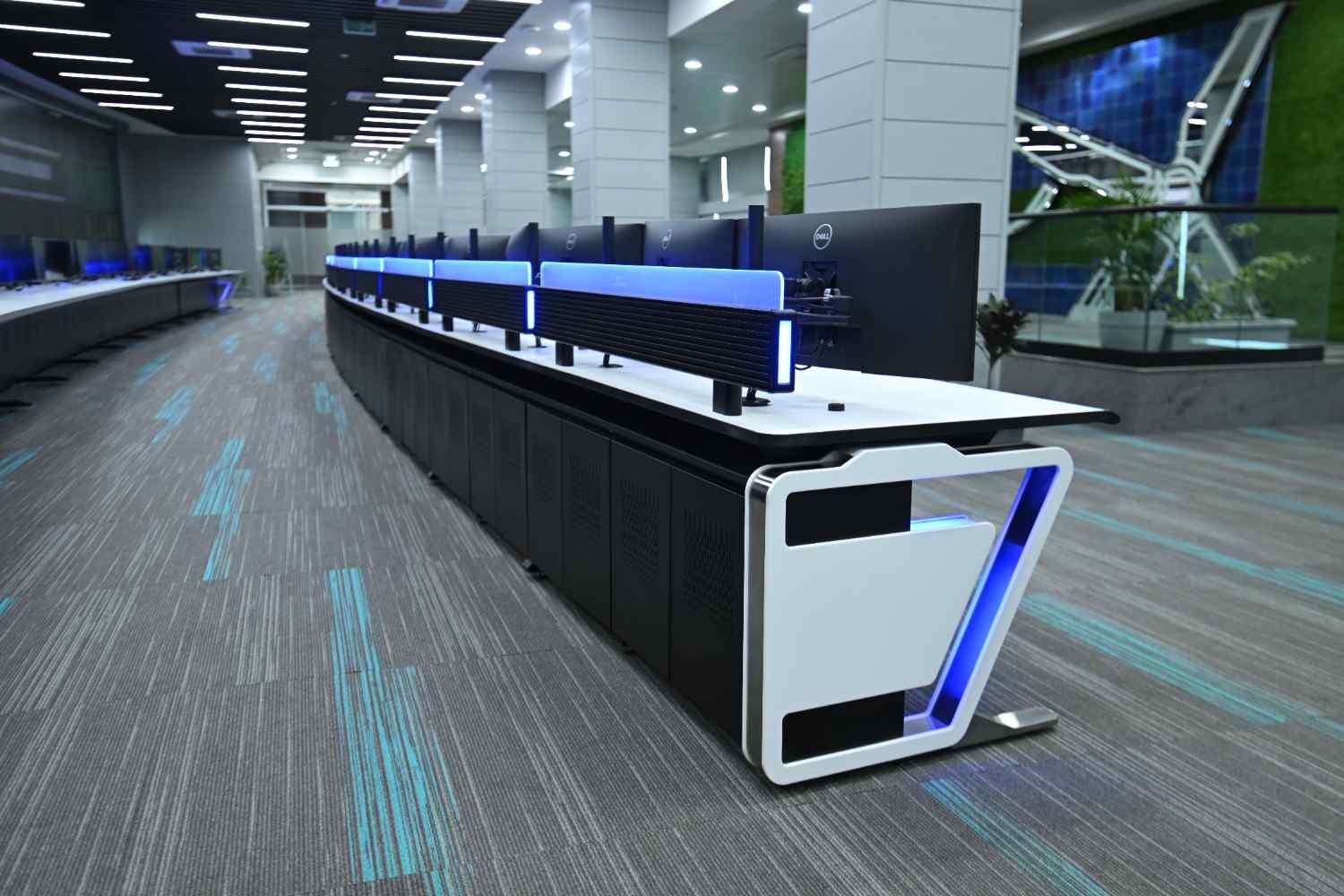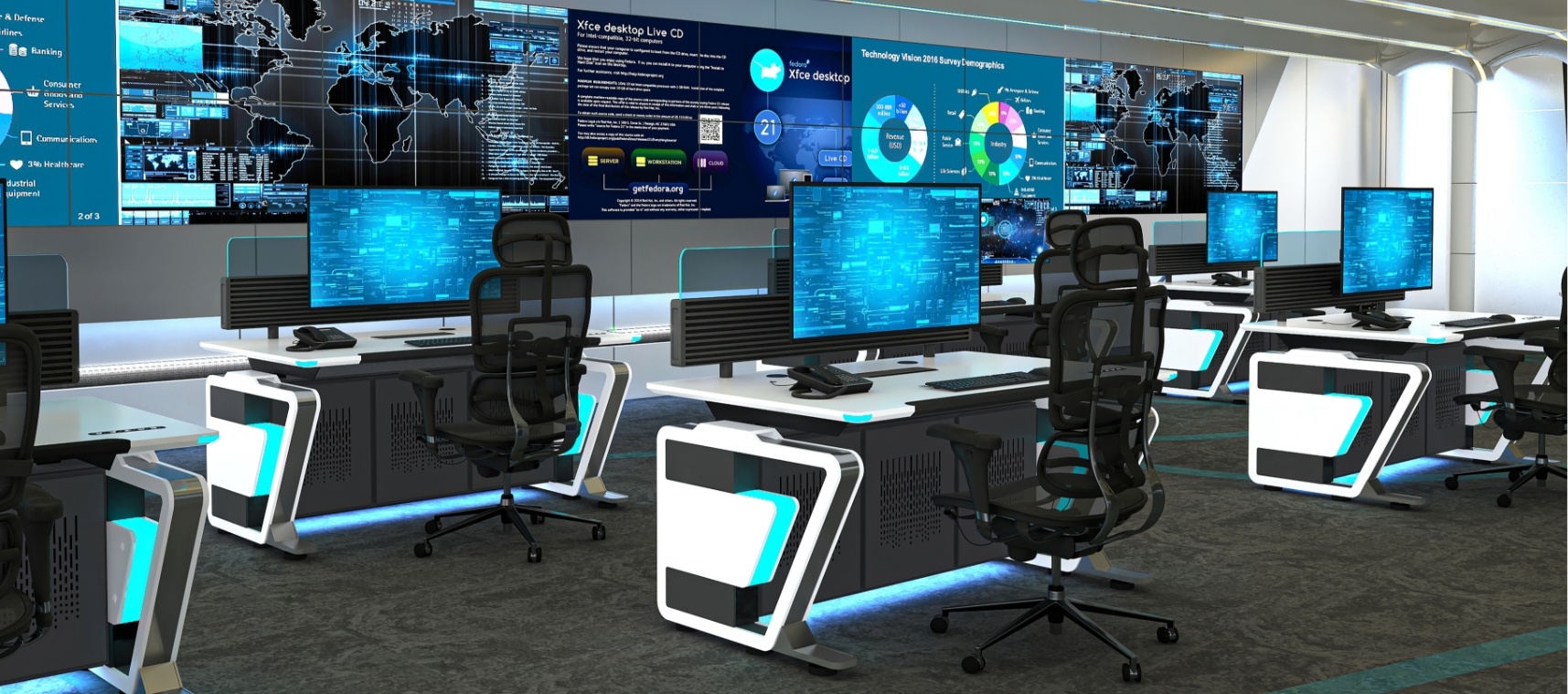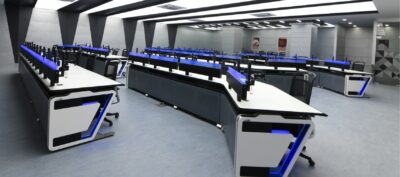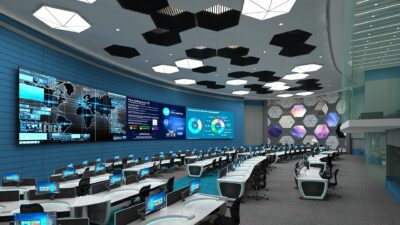
Key Elements for Building World-Class Control Centers
Key Elements for Building World-Class Control Centers
Building world-class control centers goes beyond simply arranging desks and placing equipment in a room. Control centers whether they are Command and Control Centers, Control Center Solutions for Industries, or Telecommunication Control Centers are the nerve centers of operations. The effectiveness, situational awareness, and general operational success of a control center are significantly influenced by its design.
With changing needs, today’s control centers focus on integrating advanced technology, ergonomic design, and adaptable layouts. This article will discuss the components of a superior control center and explain how Pyrotech Workspace Solutions is an expert at designing custom Control Center Setups that satisfy the specific needs of each customer.
1. Optimizing the Control Center Layout
The layout is the cornerstone of any great control center. A good control center layout guarantees that operators can access relevant information, communicate effectively, and handle systems efficiently. Teams can react quickly to any scenario with a well-planned layout that minimizes interruptions and improves workflow.
A balanced layout should account for several factors:
Operator Position: Operators should be seated comfortably, with easy access to all control systems and a clear view of their displays, ensuring they can work efficiently without strain.
Sight Lines: It’s important that supervisors and team members have a clear line of sight to each other, making communication smooth and effortless.
Movement Efficiency: A well-thought-out arrangement reduces pointless movements and increases productivity by placing electronics, consoles, and communication tools in convenient locations.
Ultimately, an effective control center layout plays a key role in ensuring smooth operations and quick, informed decision-making.
2. Ergonomics and Operator Comfort
The comfort and well-being of operators directly affect the effectiveness of Command-and-Control Centers. Control center designs must incorporate Innovative Ergonomic Solutions due to the high-pressure setting. Poor ergonomics can cause weariness, stress, and even health problems for operators who frequently put in lengthy workdays.
Here’s how ergonomics plays a role in creating world-class Control Center Solutions:
Height-Adjustable Consoles and Desks: For comfort and efficiency, height-adjustable consoles and desks are essential because they allow operators to stand or sit comfortably during their shift.
Ergonomic Chair Design: A well-designed ergonomic chair is essential for long shifts, providing support that reduces stress on the shoulders and back, keeping operators comfortable and focused.
Monitor Placement: To prevent neck strain, screens should be positioned at eye level. Adjustable chairs with arm support allow operators to find the perfect viewing angle, adding to their comfort.
Environmental relief: The control room environment should be maximized for focus, with significant attention devoted to lighting, temperature, and sound levels to minimize distractions and assist operators stay alert.
To maximize operator performance and reduce fatigue, ergonomics is more than just a luxury; it’s a vital part of the control center setup.
3. Integration and Visualization of Technology
With sophisticated systems for communication, monitoring, and decision-making, control centers are hubs for technology. Seamless integration of these technologies is critical for ensuring that the Command-and-Control Centers operate smoothly.
Key considerations include:
Centralized data monitoring: Operators must have easy access to all necessary data in a single, easily accessible central system. Large video walls, dashboard displays, and personal screens can be examples of this.
Communications systems: A robust communications infrastructure is essential to a business’s ability to operate. For telecommunications control centers, having dependable, fast communications links to other facilities, field staff, and outside partners is especially helpful.
Backup systems: In order to guarantee continuous operations in the event of disruptions, control centers need redundancy and failover systems. Data recovery, power backup, and other communication techniques are crucial to preventing downtime.
Visualization devices: Sharp, lucid data visualization is made possible by high-resolution displays, which are an essential component of contemporary control centers. These panels need to be simple to use so that operators can manage the data they require to maintain smooth operations, whether it’s surveillance footage, process monitoring, or telecom data.
4. Flexibility and Scalability
World-class control centers must be future proof. As technology evolves and operations scale, the Control Center Setup should be adaptable. A flexible design enables organizations to expand, upgrade, or reconfigure their control rooms without significant downtime or cost.
Considerations for scalability include:
Modular design: Furniture and consoles must be easily reconfigurable in response to changing operational requirements.
Expandable infrastructure: To handle future expansions in operations and technology, the IT infrastructure must be scalable.
Reconfigurable space: To adapt to evolving team sizes, new technologies, or changed processes, the control center must provide smooth space reconfiguration.
Pyrotech Workspace Solutions excels in designing adaptable, modular Control Center Solutions that grow alongside your organization’s evolving needs.
5. Security and Reliability
Control centers are often critical infrastructure for industries such as utilities, transportation, security, and telecommunications. Therefore, they must be highly secure and reliable. World-class command and control centers integrate advanced security measures to protect both physical and digital assets.
Key elements include:
Access Control: Strict access control ensures that no one is allowed into the control room, preventing unauthorized individuals from endangering operations.
Cybersecurity: To protect sensitive data and guarantee continued functioning in the modern digital age, cybersecurity is crucial.
Environmental protection: Fires, floods, and power surges are just a few examples of environmental risks that control centers need to be protected from. Using monitoring tools and redundant systems can help operators be made aware of any potential threats.
6. Specialized Control Center Solutions for Different Industries
Some industries have different needs, even though many control center design considerations apply to all industries. For example, telecommunications control centers may require more sophisticated communication technologies and innovative ergonomic solutions to regulate data flow and reduce operator fatigue during long shifts. Similarly, industries with special technical and operational requirements, such as oil and gas or transportation, may require other control center layout designs.
Pyrotech Workspace Solutions: Your Partner in Building World-Class Control Centers
Pyrotech Workspace Solutions has led the way in creating and supplying top-level control center solutions since its founding in 2006. Pyrotech focuses on designing control center layouts that are specifically tailored to each customer’s demands, emphasizing flexible, ergonomic and technologically integrated installations. Pyrotech offers customized solutions to maximize effectiveness, improve communications and guarantee long-term scalability, whether you need a command-and-control center for security, surveillance or a specialist telecommunications control center.
With over 18 years of experience in the field, Pyrotech Workspace Solutions ensures that your control center setup is not only functional but also future proof, guaranteeing performance and reliability for years to come.
FAQs
Question 1: What are the key components of a control center?
A well-thought-out layout, ergonomic design, seamless technology integration, and strong safety measures are the building blocks of an effective control center.
Question 2: Why is ergonomics so important in control center design?
In high-pressure environments, good ergonomics help operators stay comfortable, reduce fatigue, and boost productivity, making it easier to stay focused and perform at their best.
Question 3. In what ways may Pyrotech Workspace Solutions help with the design of a special control center?
Pyrotech provides specialized control center solutions that are tailored to your industry’s needs and provide efficiency, flexibility, and technology integration.
Question 4. Which sectors benefit from bespoke control center design?
To meet their operational objectives, industries such as transportation, oil and gas, utilities, and telecommunications require unique control center installations.
For such innovative and customized control center solutions, reach out to us at[email protected]






No Comments